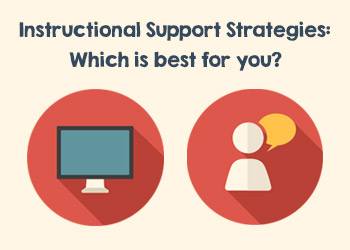
CLASS™ Instructional Support
What comes to your mind when you read this term? If you’re anything like the hundreds of coaches we’ve talked to, this term might bring to mind frustration or even anxiety—knowing that Instructional Support is typically the lowest rated domain measured by the CLASS tool—and often, the most misunderstood.
What is it about Instructional Support that is so challenging for coaches and teachers alike?
Coaching is about changing behaviors, and impacting significant behavior change is one of the hardest things to do in life, both professionally and personally. Combine the task of coaching with CLASS Instructional Support—often the lowest rated and most complex domain—and you’ve got one heck of a challenge!
This is why we’ve developed Instructional Support Strategies. We wanted to give coaches confidence in their own Instructional Support knowledge. We also wanted to provide them concrete strategies they can use to support their teachers in unpacking this complex domain and improving their interactions in it.
But with online and face-to-face training options available, how do you know which is right for you?
Use this handy chart to compare Instructional Support options!
Available for coaches and teachers— Online course options are available for coaches and teachers.
| Instructional Support Strategies (online) | Instructional Support Strategies (face-to-face) |
| No need to set a date—Interact with the course anytime, anywhere during your access period. | Set a date—Travel to a training, or book a trainer to come to your site. |
| Interact—Use a discussion board to interact with peers and Teachstone experts. | Interact—Participate in rich discussions during your training. Interact directly with a CLASS expert. |
| Apply it—Use the printable workbook to take strategies and tips back to your teachers. | Apply it—Use copy-ready resources to take strategies and tips back to your teachers. |
| Build your experience—Purchase all four learning modules in the course, or any combination of the four, depending on your needs and budget. | Fixed experience—Training covers pre-planned learning objectives and areas of focus. |
| Virtual experience—Each module is online and requires a high-speed Internet connection and basic computer skills. | In-person experience—The training is face-to-face with no computer interaction necessary. |
| Available for coaches and teachers— Online course options are available for coaches and teachers. | Best for coaches— Training is best suited for coaches or others supporting teachers. |
So which is right for you? It’s a question I can’t answer, but I hope I’ve outlined the differences in a way that helps you make your decision. Head to our website to learn more about Instructional Support Strategies online and face-to-face learning options. Or simply contact us and we’ll help you decide!
Editor's Note: This post was originally published February 21, 2014. It has been updated to ensure the content is fresh and accurate.

